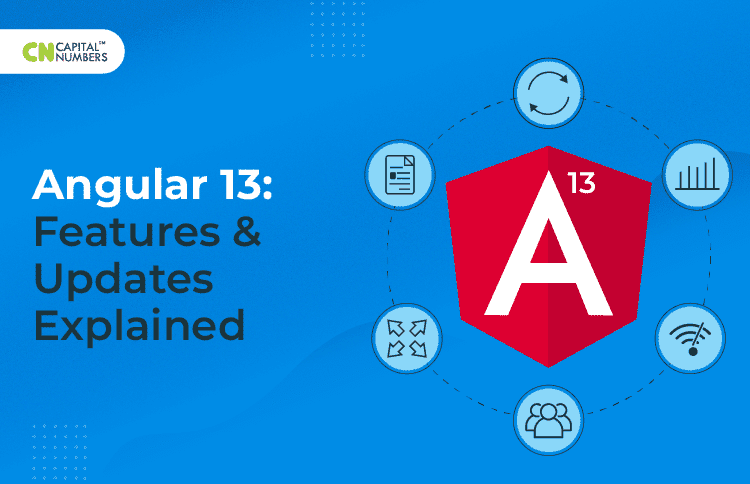Angular 13: Top New Features & Core Updates Explained
Table of Contents
Angular 13, the latest version of Google’s popular TypeScript-based free and open-source web application framework, is finally here. This all-new version of Angular was released on November 3, 2021. By far, Angular 13 is considered the most streamlined and previously planned upgrade available as a production release to create robust apps. The latest Angular version brings several essential updates and fascinating features for developers, allowing them the flexibility to develop engaging applications with more ease now.
So, if you’re still using the older Angular v12, it’s time to upgrade to version 13. All it takes is to hire Angular developers to create amazing apps built on modern web development standards. Let’s take a bird-eye view of Angular 13 core updates and new features.
1. 100% Ivy and No more Support for View Engine
Angular 13 is 100% Ivy. It no longer supports the view engine. This notable feature removes the complexity of the Angular 13 codebase and enables faster compilation and increased productivity in the framework. The framework has converted all internal tools to Ivy in advance so that every transition goes well. Moreover, Ivy assembles every component individually to accelerate the development times, making it easier for developers to improvise the dynamic components easily.
2. Typescript 4.4 Support
Angular 13 supports TypeScript 4.4, which means Angular coders can now keep the code clean and safe. They can use many fantastic language features. Another noteworthy change in TypeScript 4.4 is that it no longer implements setters and getters to get a similar type. Other key highlights of TS 4.4 include Control Flow Analysis, spelling suggestions for JavaScript, improved type guard detection, performance boost, default catch variables, new flags, IntelliSense improvements, etc.
3. Improvements to Angular Tests
Some noteworthy enhancements to TestBed are also witnessed. Angular 13 enables a new tear-down process for TestBed, which clears the DOM at the end of each test so that developers can anticipate less memory-intensive, more optimized, and speedier tests.
4. Ergonomic APIs
Angular v13 loads faster than its predecessors as it uses ergonomic code-splitting APIs and granular code breakdown at a component level. In addition, the release of ESBuild also contributes to improved performance.ESBuild is a rapid JavaScript bundler that works with terser to optimize worldwide scripts. This JS bundler allows optimized global CSS and supports framework languages like Vue, Svelte, and Elm.
5. Internet Explorer 11 Is Not Supported
Angular 13 will not support Internet Explorer 11. It has wholly dropped off parameters that were earlier needed for IE 11, such as CSS code paths, polyfills, build passes, special JS, etc. As a result, Angular can now use highly advanced browser features like CSS variables and web animations using native web APIs. The absence of IE-specific polyfills and the improved API leads to the quick loading of apps. App users will witness fast loading and a great user experience, while developers will benefit from improved APIs and infrastructure.
6. Angular Package Format Transformations
Angular 13 has made notable changes to the Angular Package Format, or APF. It denotes the structure and format of Angular framework packages and View Engine metadata. Angular 13 comes with the new version of the APF, and noteworthy modifications in it include;
- With Angular 13, older output formats, including View Engine-specific Metadata, are removed.
- JS formats like ES2020 have been standardized.
- Updated APF to support node package exports will reduce the developer’s dependency on internal APIs.
- Angular 13 libraries don’t require ngcc, offering developers speedier execution.
7. Angular Command-Line Interface Improvements
The CLI is a crucial contributory factor to Angular success. It removes complex processes like configuration and initialization on a broader scale, simplifying the development process with accessible commands. The release of Angular 13 brings significant modifications to Angular CLI for performance improvements. Some of these Angular CLI improvements include;
- Persistent build-cache toggled on by default in Angular 13.
- 68% improvement in build-cache speed leading to faster deployment activities
- Easy enabling and disabling of the build-cache feature in existing Angular apps.
Thus, ensure you hire experienced Angular developers before starting Angular JS development.
Wrapping Up
Angular is among the most popular web frameworks worldwide due to its high usability and fantastic features. The new versions of Angular are released from time to time so that developers can use new features to enhance the development process and build better applications.
So, have you tried the all-new Angular 13? If not, it’s the right time to make a move and upgrade to Angular 13. Thus, it’s the ideal time to hire Angular developers from a reliable AngularJS development company like Capital Numbers. As an Offshore Angular Development Company, we seamlessly update your existing project to the latest version and build amazing apps that support contemporary development standards. For details, schedule a call with our experts today!















